Identification of CAMTA Gene Family in Heimia myrtifolia and Expression Analysis under Drought Stress
Abstract
:1. Introduction
2. Results
2.1. Identification and Physicochemical Properties Analysis of HmCAMTA Gene Family
2.2. Prediction of the Secondary and Tertiary Protein Structure of HmCAMTA Gene Family
2.3. Analysis of Conserved Domain and Motif of HmCAMTA Gene Family
2.4. Multiple Sequence Alignment and Phylogenetic Analysis of HmCAMTA
2.5. Annotation and Enrichment Analysis of HmCAMTA Genes
2.6. Analysis of FPKM Values of Differentially Expressed HmCAMTA in Drought Plants
2.7. Tissue Specific Expression Analysis of HmCAMTA Genes
2.8. Expression Patterns of HmCAMTA Genes under Drought Stress
3. Discussion
4. Materials and Methods
4.1. Plant Materials
4.2. Identification and Physicochemical Properties Analysis of HmCAMTA Gene Family Members
4.3. Prediction of Secondary and Tertiary Protein Structure of HmCAMTA Gene Family
4.4. Analysis of Conserved Domain and Motif of HmCAMTA
4.5. Multiple Sequence Alignment and Phylogenetic Analysis of HmCAMTA
4.6. Annotation and Enrichment Analysis in GO Databases
4.7. Analysis of FPKM Values of Differentially Expressed HmCAMTA in Drought Plants
4.8. Expression Pattern Analysis of HmCAMTA Gene
5. Conclusions
Supplementary Materials
Author Contributions
Funding
Data Availability Statement
Conflicts of Interest
References
- Cho, J.; Han, G.; Lee, C.J.; Lee, S.H.; Yoo, A.Y. Evidence and prediction regarding the continuous global warming: A severe domino effect. Am. J. Environ. Sci. Eng. 2021, 5, 76–86. [Google Scholar] [CrossRef]
- Bashir, S.S.; Hussain, A.; Hussain, S.J.; Wani, O.A.; Nabi, S.Z.; Dar, N.A.; Baloch, F.S.; Mansoor, S. Plant drought stress tolerance: Understanding its physiological, biochemical and molecular mechanisms. Biotechnol. Biotechnol. Equip. 2021, 35, 1912–1925. [Google Scholar] [CrossRef]
- Jha, R.K.; Mishra, A. Introgression of SbERD4 gene encodes an early-responsive dehydration-stress protein that confers tolerance against different types of abiotic stresses in transgenic tobacco. Cells 2022, 11, 62. [Google Scholar] [CrossRef] [PubMed]
- Sun, X.; Hu, S.; Wang, X.; Liu, H.; Guan, Q. De novo assembly of Amorpha fruticosa L. transcriptome in response to drought stress provides insight into the tolerance mechanisms. PeerJ 2021, 9, e11044. [Google Scholar] [CrossRef] [PubMed]
- Chevilly, S.; Dolz-Edo, L.; Martínez-Sánchez, G.; Morcillo, L.; Vilagrosa, A.; López-Nicolás, J.; Blanca, J.; Yenush, L.; Mulet, J.M. Distinctive traits for drought and salt stress tolerance in melon (Cucumis melo L.). Front. Media 2021, 12, 777060. [Google Scholar] [CrossRef]
- Zhang, C.; Yang, H.; Wu, W.; Li, W. Effect of drought stress on physiological changes and leaf surface morphology in the blackberry. Braz. J. Bot. 2017, 40, 625–634. [Google Scholar] [CrossRef]
- Romano, D. Morphological, physiological, and biochemical responses of zinnia to drought stress. Horticulturae 2021, 7, 362. [Google Scholar] [CrossRef]
- Chong, L.; Xu, R.; Huang, P.; Guo, P.; Zhu, M.; Du, H.; Sun, X.; Lixia, K.; Zhu, J.K.; Zhu, Y. The tomato OST1–VOZ1 module regulates drought-mediated flowering. Plant Cell 2022, 34, 2001–2018. [Google Scholar] [CrossRef]
- Yang, G.; Li, D.; Peng, S.A.; Gao, X.; Chen, S.; Wang, T.; Su, L.A.; Xu, Z.A.; Zhai, M.A. Walnut JrGSTU23 and JrVHAc4 involve in drought tolerance via JrWRKY2-mediated upstream regulatory pathway. Sci. Hortic. 2022, 295, 110871. [Google Scholar] [CrossRef]
- Song, Q.; Kong, L.; Yang, X.; Jiao, B.; Hu, J.; Zhang, Z.; Xu, C.; Luo, K. PtoMYB142, a poplar R2R3-MYB transcription factor, contributes to drought tolerance by regulating wax biosynthesis. Tree Physiol. 2022, 42, 2133–2147. [Google Scholar] [CrossRef]
- Du, L.; Ali, G.S.; Simons, K.A.; Hou, J.; Yang, T.; Reddy, A.S.; Poovaiah, B.W. Ca(2+)/calmodulin regulates salicylic-acid-mediated plant immunity. Nature 2009, 457, 1154–1158. [Google Scholar] [CrossRef]
- Hashimoto, K.; Kudla, J. Calcium decoding mechanisms in plants. Biochimie 2011, 93, 2054–2059. [Google Scholar] [CrossRef]
- Reddy, V.S.; Reddy, A.S. Proteomics of calcium-signaling components in plants. Phytochemistry 2004, 65, 1745–1776. [Google Scholar] [CrossRef]
- Dong, F.; Yang, F.; Liu, Y.; Jia, W.; Zhou, S. Calmodulin-binding transcription activator (CAMTA)/ factors in plants. In Calcium Transport Elements in Plants; Academic Press: Cambridge, MA, USA, 2021. [Google Scholar] [CrossRef]
- Bouche, N.; Yellin, A.; Snedden, W.A.; Fromm, H. Plant-specific calmodulin-binding proteins. Annu. Rev. Plant Biol. 2005, 56, 435–466. [Google Scholar] [CrossRef]
- Kim, M.C.; Chung, W.S.; Yun, D.J.; Cho, M.J. Calcium and calmodulin-mediated regulation of gene expression in plants. Mol. Plant 2009, 2, 13–21. [Google Scholar] [CrossRef] [Green Version]
- Bouché, N.; Scharlat, A.; Snedden, W.; Bouchez, D.; Fromm, H. A novel family of Calmodulin-binding transcription activators in multicellular organisms. J. Biol. Chem. 2002, 277, 21851–21861. [Google Scholar] [CrossRef] [Green Version]
- Reddy, A.; Ali, G.S.; Celesnik, H.; Day, I.S. Coping with stresses: Roles of Calcium- and Calcium/Calmodulin-regulated gene expression. Plant Cell 2011, 23, 2010–2032. [Google Scholar] [CrossRef] [Green Version]
- Doherty, C.J.; Buskirk, H.V.; Myers, S.J.; Thomashow, M.F. Roles for Arabidopsis CAMTA transcription factors in cold-regulated gene expression and freezing tolerance. Plant Cell 2009, 21, 972–984. [Google Scholar] [CrossRef] [Green Version]
- Pandey, N.; Ranjan, A.; Pant, P.; Tripathi, R.K.; Ateek, F.; Pandey, H.P.; Patre, U.V.; Sawant1, S.V. CAMTA 1 regulates drought responses in Arabidopsis thaliana. BMC Genom. 2013, 14, 216. [Google Scholar] [CrossRef]
- Galon, Y.; Nave, R.; Boyce, J.M.; Nachmias, D.; Knight, M.R.; Fromm, H. Calmodulin-binding transcription activator (CAMTA) 3 mediates biotic defense responses in Arabidopsis. FEBS Lett. 2008, 582, 943–948. [Google Scholar] [CrossRef] [Green Version]
- Forner-Giner, M.N. Gene expression under short-term low temperatures: Preliminary screening method to obtain tolerant citrus rootstocks. Horticulturae 2021, 7, 447. [Google Scholar] [CrossRef]
- Liu, J.; Zhu, J.K. An Arabidopsis mutant that requires increased calcium for potassium nutrition and salttolerance. Proc. Natl. Acad. Sci. USA 1997, 94, 14960–14964. [Google Scholar] [CrossRef] [PubMed] [Green Version]
- Thomashow, M.F. Role of cold-responsive genes in plant freezing tolerance. Plant Physiol. 1998, 118, 1–7. [Google Scholar] [CrossRef] [PubMed] [Green Version]
- Wei, M.; Xu, X.; Li, C. Identification and expression of CAMTA genes in Populus trichocarpa under biotic and abiotic stress. Sci. Rep. 2017, 7, 17910. [Google Scholar] [CrossRef] [PubMed] [Green Version]
- Kakar, K.U.; Zarqa, N.; Zhouqi, C.; Peijian, C.; Jingjing, J.; Qingyao, S.; Xueliang, R. Evolutionary and expression analysis of CAMTA gene family in Nicotiana tabacum yielded insights into their origin, expansion and stress responses. Sci. Rep. 2018, 8, 10322. [Google Scholar] [CrossRef] [Green Version]
- İlker, B.; Emre, İ.; Dilara, Ş.; Umut, A.Ö.; Sümer, A. Genome-wide identification of CAMTA gene family members in Phaseolus vulgaris L. and their expression profiling during salt stress. Mol. Biol. Rep. 2019, 46, 2721–2732. [Google Scholar] [CrossRef]
- Pant, P.; Iqbal, Z.; Pandey, B.K.; Sawant, S.V. Genome-wide comparative and evolutionary analysis of Calmodulin-binding Transcription Activator (CAMTA) family in Gossypium species. Sci. Rep. 2018, 8, 5573. [Google Scholar] [CrossRef] [Green Version]
- Lourteig, A. Legitimacy of Heimia myrtifolia Chamisso et Schlechtendal (Lythraceae). Taxon 1989, 38, 279–280. [Google Scholar] [CrossRef]
- Clemens, S. Frequent oligolecty characterizing a diverse bee–plant community in a xerophytic bushland of subtropical Brazil. Stud. Neotrop. Fauna Environ. 1998, 33, 46–59. [Google Scholar] [CrossRef]
- Ayoub, N.; Singab, A.N.; Elnaggar, M.; Lindequist, U. Investigation of phenolic leaf extract of Heimia myrtifolia (Lythraceae): Pharmacological properties (stimulation of mineralization of SaOS-2 osteosarcoma cells) and identification of polyphenols. Drug Discov. Today 2010, 4, 341–348. [Google Scholar]
- Gu, C.; Dong, B.; Xu, L.; Tembrock, L.R.; Zheng, S.; Wu, Z. The complete chloroplast genome of Heimia myrtifolia and comparative analysis within Myrtales. Molecules 2018, 23, 846. [Google Scholar] [CrossRef] [Green Version]
- Lin, L.; Wang, J.; Wang, Q.; Ji, M.; Hong, S.; Shang, L.; Zhang, G.; Zhao, Y.; Ma, Q.; Gu, C. Transcriptome approach reveals the response mechanism of Heimia myrtifolia (Lythraceae, Myrtales) to drought stress. Front. Plant Sci. 2022, 13, 877913. [Google Scholar] [CrossRef]
- Geng, R.; Ke, X.; Wang, C.; He, Y.; Wang, H.; Zhu, Z. Genome-wide identification and expression analysis of transcription factors in Solanum lycopersicum. Agri. Gene 2017, 6, 14–23. [Google Scholar] [CrossRef]
- Yang, T.; Poovaiah, B.W. A calmodulin-binding/CGCG box DNA-binding protein family involved in multiple signaling pathways in plants. J. Biol. Chem. 2002, 277, 45049–45058. [Google Scholar] [CrossRef] [Green Version]
- Ali, E.; Raza, M.A.; Cai, M.; Hussain, N.; Sun, P. Calmodulin-binding transcription activator (CAMTA) genes family: Genome-wide survey and phylogenetic analysis in flax (Linum usitatissimum). PLoS ONE 2020, 15, e0236454. [Google Scholar] [CrossRef]
- Yue, R.; Lu, C.; Sun, T.; Peng, T.; Han, X.; Qi, J.; Yan, S.; Tie, S. Identification and expression profiling analysis of calmodulin-binding transcription activator genes in maize (Zea mays L.) under abiotic and biotic stresses. Front. Plant Sci. 2015, 6, 576. [Google Scholar] [CrossRef] [Green Version]
- Noman, M.; Jameel, A.; Qiang, W.; Ahmad, N.; Liu, W.; Wang, F.; Li, H. Overexpression of GmCAMTA12 Enhanced Drought Tolerance in Arabidopsis and Soybean. Int. J. Mol. Sci. 2019, 20, 4849. [Google Scholar] [CrossRef] [Green Version]
- Ghatak, A.; Chaturvedi, P.; Nagler, M.; Roustan, V.; Lyon, D.; Bachmann, G.; Postl, W.; Schröfl, A.; Desai, N.; Varshney, R.K.; et al. Comprehensive tissue-specific proteome analysis of drought stress responses in Pennisetum glaucum (L.) R. Br. (Pearl millet). J. Proteom. 2016, 143, 122–135. [Google Scholar] [CrossRef] [Green Version]
- Miao, Z.; Han, Z.; Zhang, T.; Chen, S.; Ma, C. A systems approach to a spatio-temporal understanding of the drought stress response in maize. Sci. Rep. 2017, 7, 6590. [Google Scholar] [CrossRef] [Green Version]
- Liu, B.; Liang, H.; Wu, C.; Huang, X.; Wen, X.; Wang, M.; Tang, H. Physiological and transcriptomic responses of illicium difengpi to drought stress. Sustainability 2022, 14, 7479. [Google Scholar] [CrossRef]
- Hafizur, R.; Xu, Y.P.; Zhang, X.R.; Cai, X.Z. Brassica napus genome possesses extraordinary high number of CAMTA genes and CAMTA3 contributes to PAMP triggered immunity and resistance to Sclerotinia sclerotiorum. Front. Plant Sci. 2016, 7, 581. [Google Scholar] [CrossRef] [Green Version]
- Punta, M.; Coggill, P.C.; Eberhardt, R.Y.; Mistry, J.; Tate, J.; Boursnell, C.; Pang, N.; Forslund, K.; Ceric, G.; Clements, J.; et al. The Pfam protein families database. Nucleic Acids Res. 2012, 40, D290–D301. [Google Scholar] [CrossRef] [PubMed] [Green Version]
- Guo, A.; Chen, X.; Gao, G.; Zhang, H.; Zhu, Q.; Liu, X.; Zhong, Y.; Gu, X.; He, K.; Luo, J. PlantTFDB: A comprehensive plant transcription factor database. Nucleic Acids Res. 2008, 36, D966–D969. [Google Scholar] [CrossRef] [PubMed] [Green Version]
- Aron, M.B.; Yu, B.; Lianyi, H.; Jane, H.; Lanczycki, C.J.; Shennan, L.; Farideh, C.; Derbyshire, M.K.; Geer, R.C.; Gonzales, N.R. CDD/SPARCLE: Functional classification of proteins via subfamily domain architectures. Nucleic Acids Res. 2017, 45, D200–D203. [Google Scholar] [CrossRef] [Green Version]
- Letunic, I.; Doerks, T.; Bork, P. SMART: Recent updates, new developments and status in 2015. Nucleic Acids Res. 2015, 43, D257–D260. [Google Scholar] [CrossRef] [PubMed]
- Bjellqvist, B.; Hughes, G.J.; Pasquali, C.; Paquet, N.; Ravier, F.; Sanchez, J.C.; Frutiger, S.; Hochstrasser, D. The focusing positions of polypeptides in immobilized pH gradients can be predicted from their amino acid sequences. Electrophoresis 1993, 14, 1023–1031. [Google Scholar] [CrossRef]
- Chou, K.; Shen, H. Plant-mPLoc: A top-down strategy to augment the power for predicting plant protein subcellular localization. PLoS ONE 2010, 5, e11335. [Google Scholar] [CrossRef] [Green Version]
- Geourjon, C.; Deléage, G. SOPMA: Significant improvements in protein secondary structure prediction by consensus prediction from multiple alignments. Comput. Appl. Biosci. 1995, 11, 681–684. [Google Scholar] [CrossRef]
- Schwede, T.; Kopp, J.; Guex, N.; Peitsch, M.C. SWISS-MODEL: An automated protein homology-modeling server. Nucleic Acids Res. 2003, 31, 3381–3385. [Google Scholar] [CrossRef] [Green Version]
- Chen, C.; Chen, H.; Zhang, Y.; Thomas, H.R.; Frank, M.H.; He, Y.; Xia, R. TBtools: An integrative toolkit developed for interactive analyses of big biological data. Mol. Plant 2020, 13, 1194–1202. [Google Scholar] [CrossRef]
- Kumar, S.; Nei, M.; Dudley, J.; Tamura, K. MEGA: A biologist-centric software for evolutionary analysis of DNA and protein sequences. Brief. Bioinform. 2008, 9, 299–306. [Google Scholar] [CrossRef] [Green Version]
- Li, J.; Miao, B.; Wang, S.; Dong, W.; Xu, H.; Si, C.; Wang, W.; Duan, S.; Lou, J.; Bao, Z.; et al. Hiplot: A comprehensive and easy-to-use web service for boosting publication-ready biomedical data visualization. Brief. Bioinform. 2022, 23. [Google Scholar] [CrossRef]
- Livak, K.J.; Schmittgen, T.D. Analysis of relative gene expression data using real-time quantitative PCR and the 2−ΔΔCT method. Methods 2001, 25, 402–408. [Google Scholar] [CrossRef]
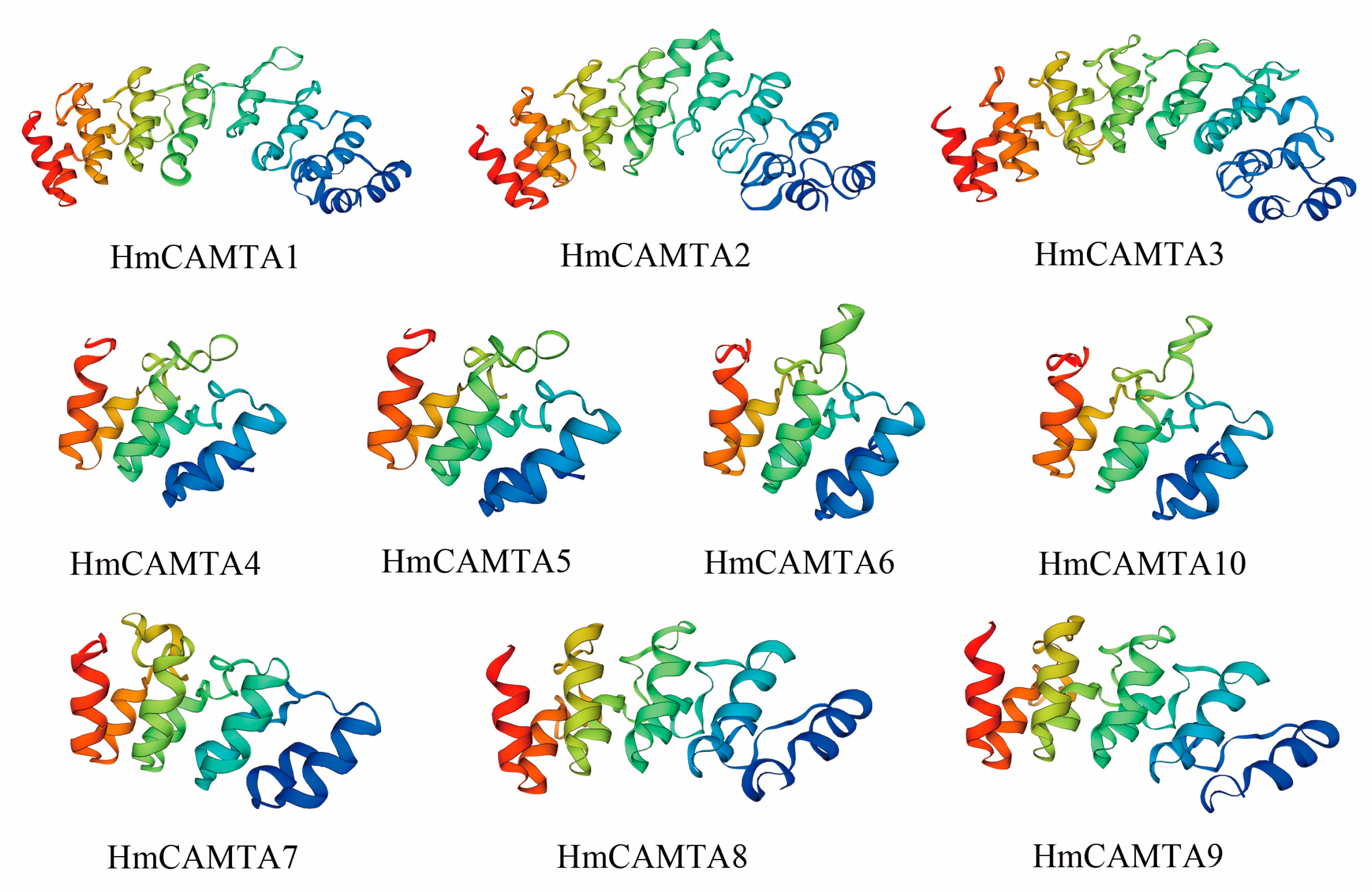
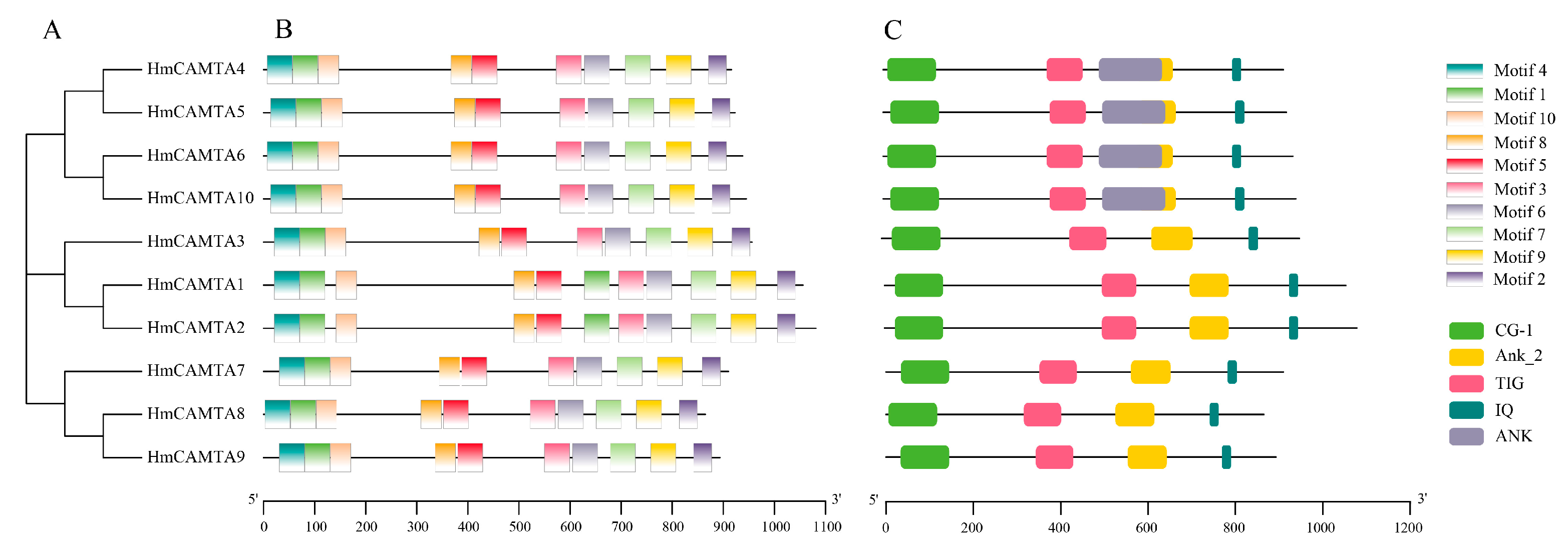


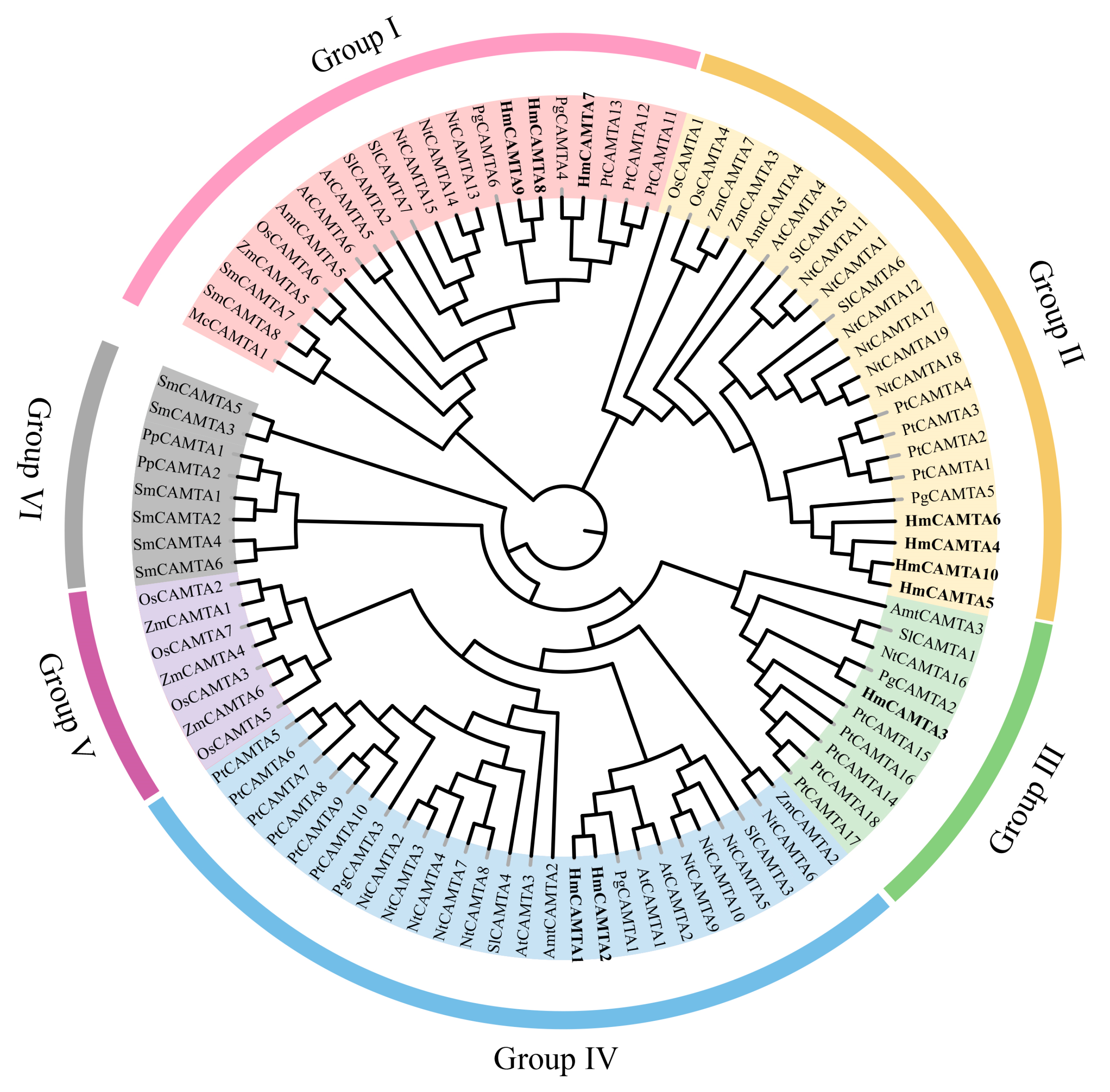
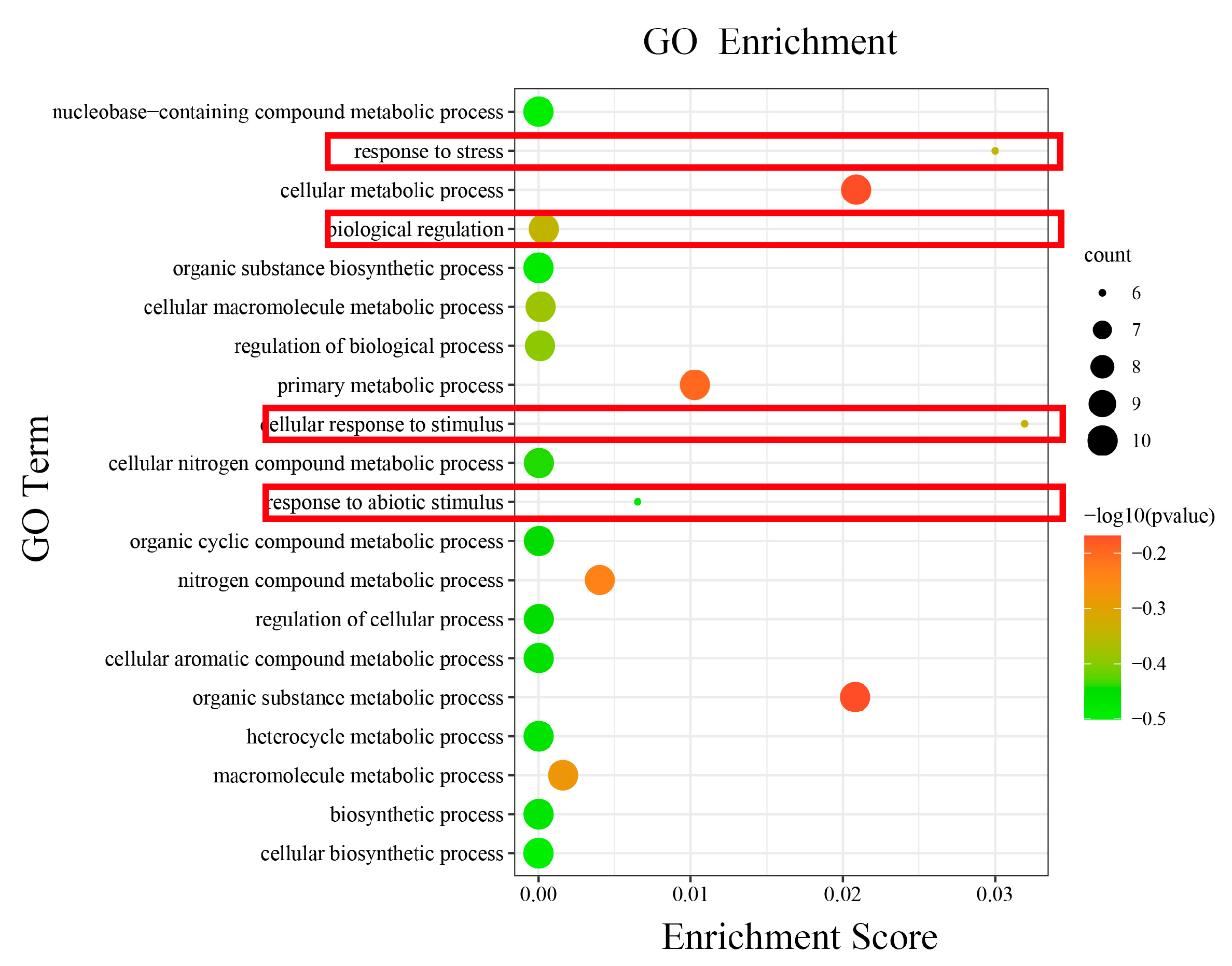
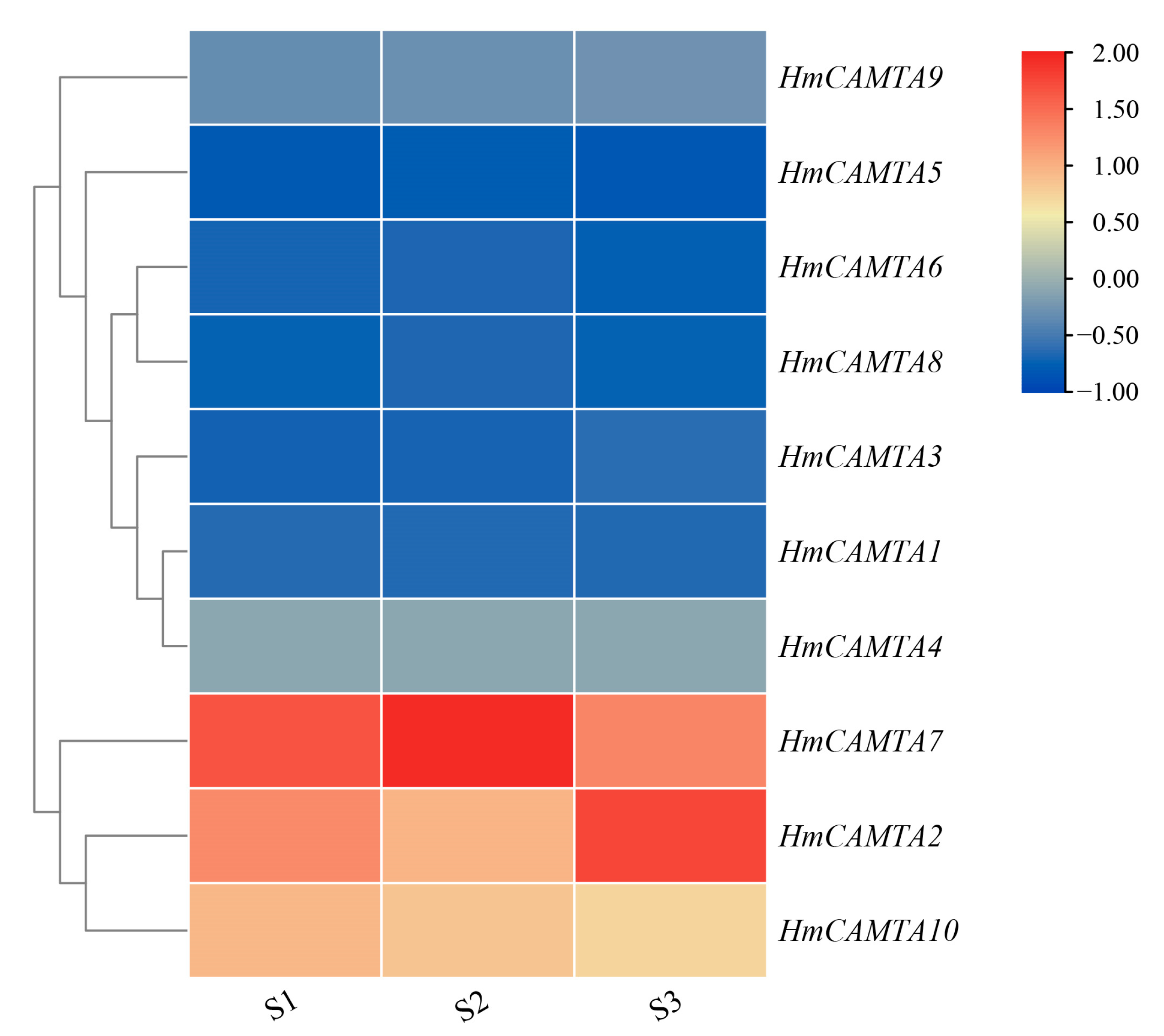

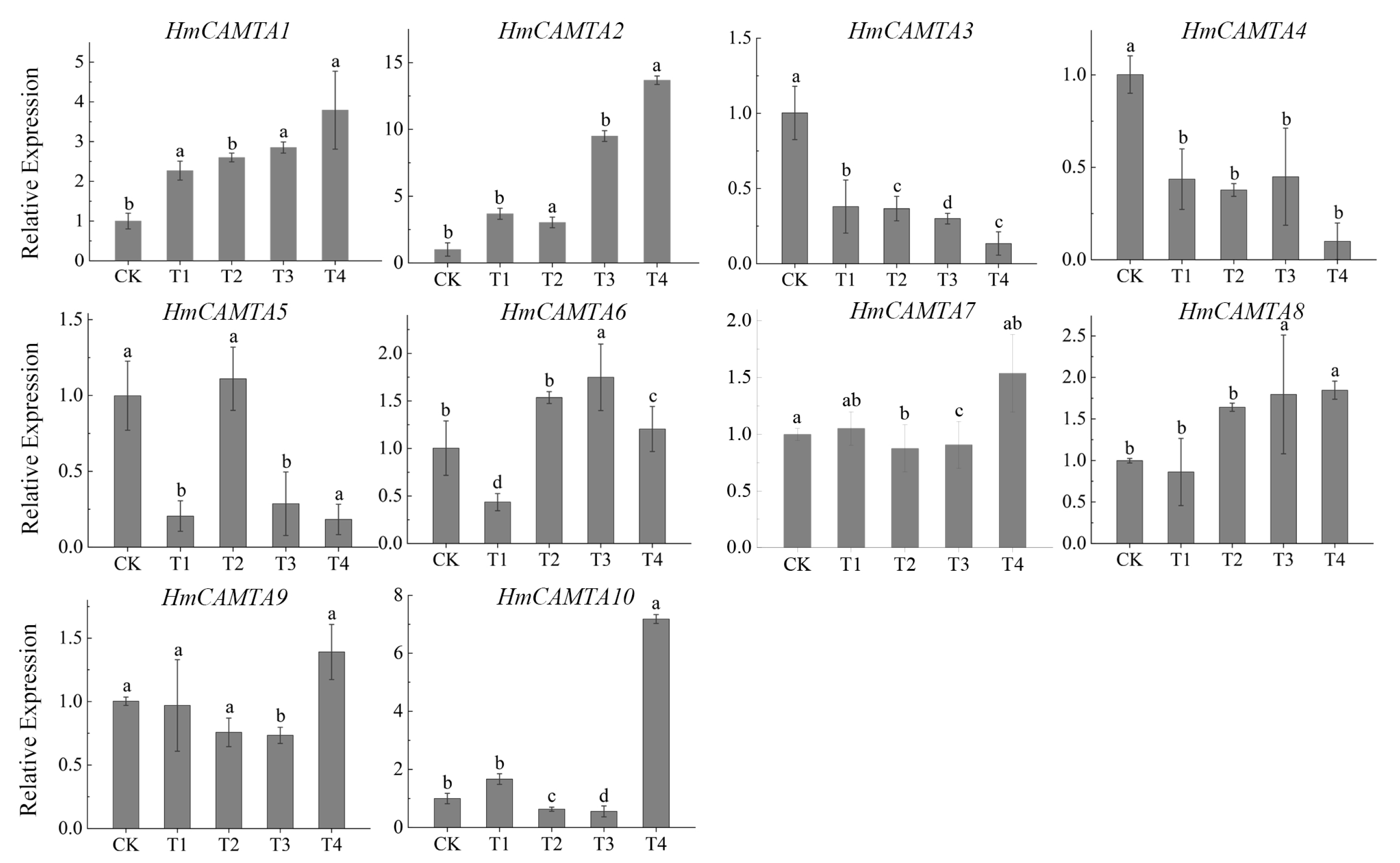
| Protein Name | No.of Amino Acid/AA | Molecular Weight/Da | Isoelectric Point | Percentage of the Amino Acids with Highest Content/% | Protein Instability Index | GRAVY | Subcellular Localization |
|---|---|---|---|---|---|---|---|
| HmCAMTA1 | 1055 | 117,935.28 | 6.14 | Ala (A) 6.6 | 77 | −0.538 | Nucleus |
| HmCAMTA2 | 1080 | 120,654.14 | 5.67 | Ala (A) 6.6 | 76.56 | −0.541 | Nucleus |
| HmCAMTA3 | 955 | 106,484 | 8.05 | Ala (A) 9.3 | 77.05 | −0.467 | Nucleus |
| HmCAMTA4 | 915 | 102,392.76 | 5.83 | Ala (A) 6.7 | 78.64 | −0.505 | Nucleus |
| HmCAMTA5 | 922 | 103,117.55 | 5.83 | Ala (A) 6.7 | 78.16 | −0.504 | Nucleus |
| HmCAMTA6 | 937 | 104,717 | 5.54 | Ala (A) 6.8 | 77.12 | −0.519 | Nucleus |
| HmCAMTA7 | 909 | 102,908.94 | 6.55 | Ala (A) 7.7 | 78.47 | −0.504 | Nucleus |
| HmCAMTA8 | 864 | 98,275.23 | 7 | Ala (A) 7.6 | 78.83 | −0.5 | Nucleus |
| HmCAMTA9 | 892 | 101,172.53 | 6.61 | Ala (A) 7.4 | 79.96 | −0.476 | Nucleus |
| HmCAMTA10 | 944 | 105,441.79 | 5.54 | Ala (A) 6.9 | 76.65 | −0.518 | Nucleus |
| Protein Name | Alpha Helix/% | Beta Turn/% | Random Coil/% | Extended Strand/% |
|---|---|---|---|---|
| HmCAMTA1 | 40.85 | 5.31 | 45.21 | 8.63 |
| HmCAMTA2 | 41.57 | 5.19 | 45.19 | 8.06 |
| HmCAMTA3 | 44.29 | 6.07 | 41.88 | 7.75 |
| HmCAMTA4 | 42.51 | 5.57 | 41.64 | 10.27 |
| HmCAMTA5 | 43.28 | 5.97 | 40.46 | 10.3 |
| HmCAMTA6 | 41.3 | 5.55 | 42.58 | 10.57 |
| HmCAMTA7 | 45.43 | 5.94 | 39.27 | 9.35 |
| HmCAMTA8 | 46.18 | 6.02 | 37.73 | 10.07 |
| HmCAMTA9 | 45.18 | 5.72 | 39.24 | 9.87 |
| HmCAMTA10 | 42.27 | 5.93 | 41.63 | 10.17 |
| Gene Name | Forward Primer (5′-3′) | Reverse Primer (5′-3′) |
|---|---|---|
| HmCAMTA1 | AGCCAAACAGCAACCACAGG | ATAAGCCAAGTCCAAACCTAAAGAG |
| HmCAMTA2 | AGCCAAACAGCAACCACAGG | ATAAGCCAAGTCCAAACCTAAAGAG |
| HmCAMTA3 | TTCTACAGCCCGAGACGAGG | GAATCATCCCAATCCCGACC |
| HmCAMTA4 | GAACGAACAACAAGAAAGGCAAGG | GCCGCATAGAAAAGACCCAACT |
| HmCAMTA5 | ACGAACAACAAGAAAGGCAAGG | GCCGCATAGAAAAGACCCAACT |
| HmCAMTA6 | CAAAGTTGACCTCACGGCACA | AAATCCTTCCGACCCTTCCA |
| HmCAMTA7 | CTTCCAAAACCTCGCACCTAAT | AGCTTTTATACCCGCCGATTAC |
| HmCAMTA8 | AGTTCCTTAATTTGCGGAATAAGGC | TCCTGTAATCTTCCTGTGCCTTC |
| HmCAMTA9 | CTGGGCAGCATACTATGGGAGG | CGGCGAGGTAAGCGGATAAAC |
| HmCAMTA10 | CAAAGTTGACCTCACGGCACA | AAATCCTTCCGACCCTTCCA |
| HmGAPDH | AGAAGGTCGTCATTTCTGCCC | TGGTTGTGCAGCTAGCGTTG |
Publisher’s Note: MDPI stays neutral with regard to jurisdictional claims in published maps and institutional affiliations. |
© 2022 by the authors. Licensee MDPI, Basel, Switzerland. This article is an open access article distributed under the terms and conditions of the Creative Commons Attribution (CC BY) license (https://creativecommons.org/licenses/by/4.0/).
Share and Cite
Yang, L.; Zhao, Y.; Zhang, G.; Shang, L.; Wang, Q.; Hong, S.; Ma, Q.; Gu, C. Identification of CAMTA Gene Family in Heimia myrtifolia and Expression Analysis under Drought Stress. Plants 2022, 11, 3031. https://doi.org/10.3390/plants11223031
Yang L, Zhao Y, Zhang G, Shang L, Wang Q, Hong S, Ma Q, Gu C. Identification of CAMTA Gene Family in Heimia myrtifolia and Expression Analysis under Drought Stress. Plants. 2022; 11(22):3031. https://doi.org/10.3390/plants11223031
Chicago/Turabian StyleYang, Liyuan, Yu Zhao, Guozhe Zhang, Linxue Shang, Qun Wang, Sidan Hong, Qingqing Ma, and Cuihua Gu. 2022. "Identification of CAMTA Gene Family in Heimia myrtifolia and Expression Analysis under Drought Stress" Plants 11, no. 22: 3031. https://doi.org/10.3390/plants11223031









